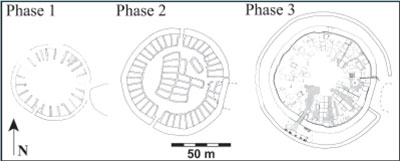Eketorp Fort—a prehistoric ring fort—was completely excavated between 1964 and 1974. The first fort (Eketorp I) was built during the Scandinavian Iron Age (ca. AD 300) near the edge of a lake that had been used for animal sacrifices since the birth of Christ. Inside the fort, shelters with openings toward the center were built around the outer enclosing curtain wall. Since only a few shelters had small fireplaces and archaeologists found very few artifacts, it seems likely that this fort was used only on special occasions—when people gathered to make sacrifices to their gods or as a refuge during periods of unrest.
Around AD 400 Eketorp I was torn down and rebuilt (Eketorp II) as a fortified hamlet with a permanent population of farmers. This phase of the fort has been reconstructed for tourism. This new fort was bigger (80 m in diameter) and contained 53 structures made of stone, including 22 dwellings, 12 storehouses, 12 byres (cow barns), and an iron forge. Its inhabitants were not particularly rich or poor compared to the wider Ölandic society. Each household probably had about seven members, totaling about 150 people for the entire fort. The discovery of weapons, tools, jewelry, and large amounts of bones indicate the fort was occupied year round by people who kept cows, sheep, goats, horses, pigs, cats, dogs, hens, and geese.

During the 5th century—a relatively wealthy period on Öland—its population was probably larger than today’s. Many gold Roman coins—the so-called solidi—are known from this time. They were probably earned by Ölandic warriors serving as mercenaries in the Roman and Hunno-Ostrogothic armies that fought for control over mainland Europe. The north gate of Eketorp II has indications that it was protected by a portcullis—an iron gate that slid down vertical grooves to block the entrance. If this is so, it was a unique example of Roman technology transferred to northern Europe at this time.
Around AD 650, Eketorp and all the other forts on Öland were abandoned. This suggests a period of relative peace when individual farmsteads were dispersed across the island. Although the fort remained empty for about 500 years, the lake outside its walls continued as a sacrificial site up to AD 1000. The only major event during this period was a battle that occurred during the Viking Period (AD 800–1050).
Around AD 1170, Eketorp was once again occupied (Eketorp III)—this time as a military garrison for heavy cavalry during the formation of the Kingdom of Sweden. The previous fort (Eketorp II) was rebuilt and supplemented by an outer wall. Some of these elements have also been reconstructed today. This fortress had wooden buildings inside its walls. One of these was a large kitchen to feed the garrison. Between the inner and outer walls of the fort, six forges produced weapons and boat rivets. Archaeologists have found many of these weapons, including spears, swords, shields, arrows, and caltrops (spiked traps to impede horses), as well as many pieces of (sometimes precious) horse equipment.
During this period, at least three other Iron Age ring forts on Öland were also rebuilt and reused in the same manner, when two powerful families were fighting over the Kingdom of Sweden. The one that controlled Öland also would control the important sailing routes on either side of the island and the herring fishing grounds off its southern tip. This phase ended around AD 1240 when the Sverker family successfully gained the throne and the fort was abandoned once and for all.
